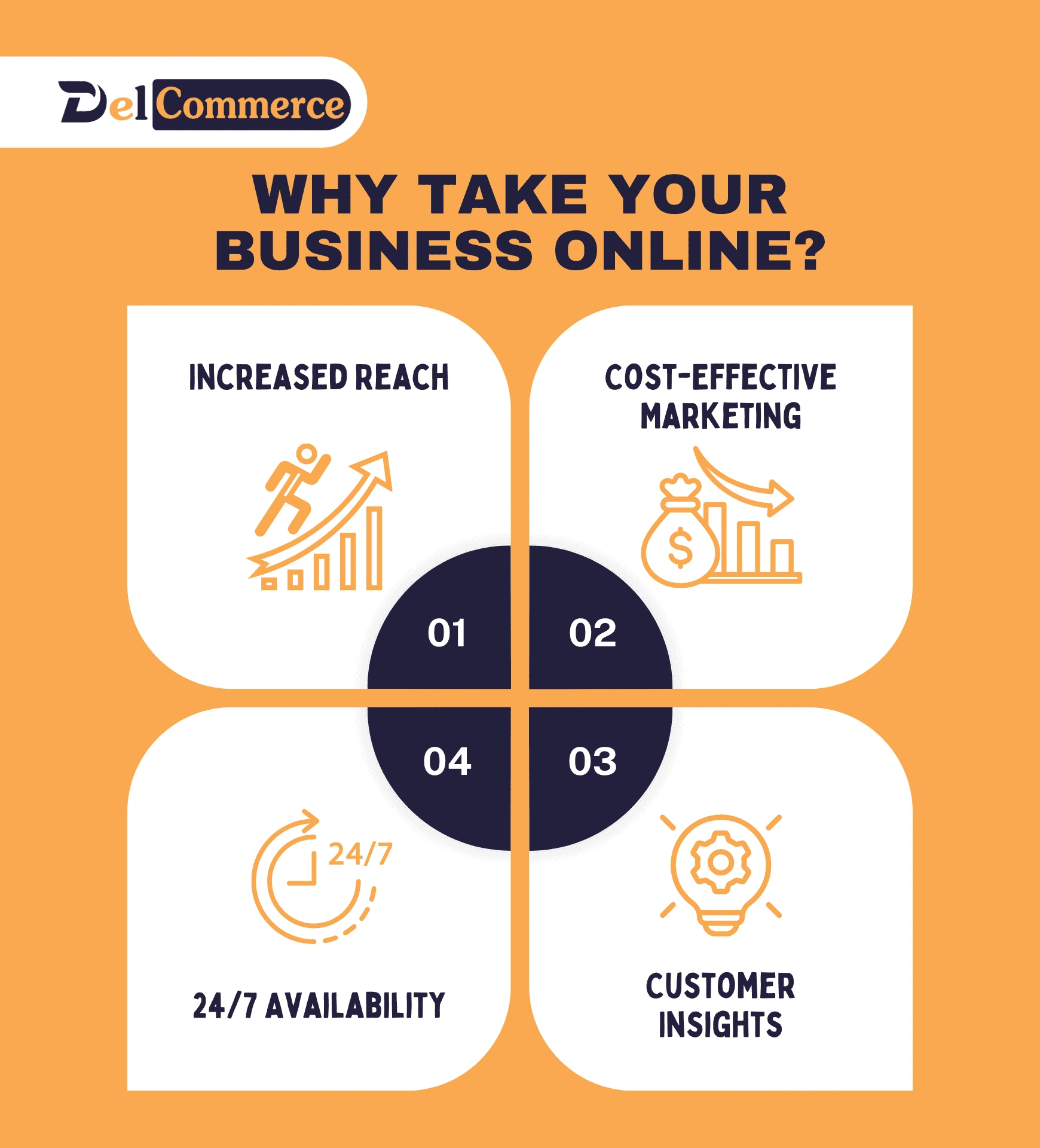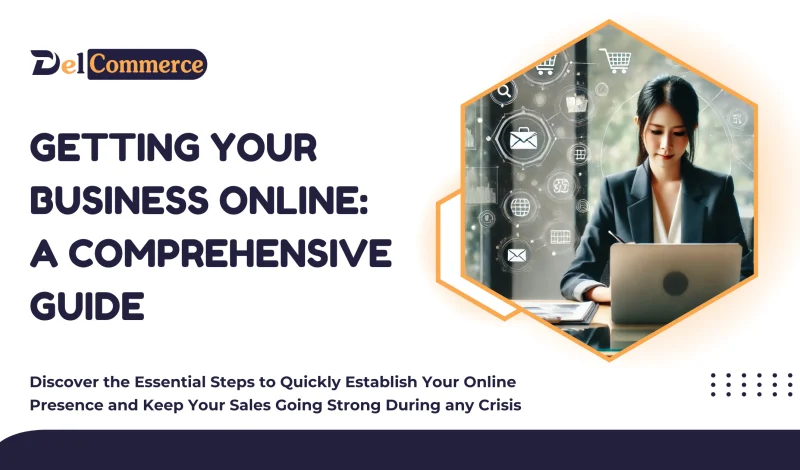Every business needs an online presence in today’s digital era. Transitioning your business to the Internet can expand your market reach, boost visibility, and improve customer interaction, whether you’re a small local store or a large company. This detailed guide will help you get your business online smoothly and successfully.
Why Get Your Business Online?
Before diving into the how-tos, it’s essential to understand why taking your business online is beneficial. Here are a few compelling reasons:
- Increased Reach: An online presence allows you to reach a global audience, far beyond your local community.
- Cost-Effective Marketing: Digital marketing can be more affordable and targeted compared to traditional marketing methods.
- 24/7 Availability: An online store never closes, providing customers the convenience to shop at any time.
- Customer Insights: Digital tools provide valuable data on customer behavior, helping tailor your offerings and marketing strategies.

Step-by-Step Guide to Get Your Business Online
1. Define Your Goals
Before you start, outline your primary objectives. Are you looking to sell products, provide information, generate leads, or enhance customer service? Your goals will shape your online strategy and the tools you choose.
2. Choose a Domain Name
Your domain name is your online address. It should be:
- Short and Memorable: Easily remembered and typed.
- Relevant: Consider your business name or services.
- SEO-Friendly: Include keywords if possible to improve search engine ranking.
3. Select a Reliable Web Hosting Service
Hosting services store your website’s files and make them accessible on the Internet. Consider factors like:
- Uptime Guarantee: Guarantee your site is continuously available.
- Customer Support: 24/7 support can be significant in case you encounter issues.
- Scalability: The ability to handle increased traffic as your business grows.
4. Design Your Website
Your site is the face of your business online. It should be:
- User-Friendly: Easy navigation and a clean layout improve user experience.
- Mobile-Responsive: Ensure it works well on all devices, as a significant portion of traffic comes from mobile users.
- SEO-Optimized: Implement SEO best practices to rank higher on search engines.
Essential Pages to Include:
- Home Page: A welcoming overview of your business.
- About Us: Your story, mission, and values.
- Products/Services: Detailed information on what you offer.
- Contact Us: Make it simple for clients to reach you.
- Blog: Regular updates can drive traffic and improve SEO.
5. Set Up an E-Commerce Platform
When planning to sell products online, select an e-commerce platform that meets your requirements. When selecting an e-commerce platform, take the following factors into account:
- Shopify: User-friendly and packed with features.
- WooCommerce: A WordPress plugin that offers flexibility.
- BigCommerce: Scalable and robust for larger stores.
When selecting an e-commerce platform, keep the following in mind:
- Ease of Use: The platform should be simple to set up and oversee.
- Customization: Look for customization options to align the online store with your brand.
- Integration: Ensure it integrates well with other tools you use, like your CRM and email marketing software.
- Payment Processing: Verify that the platform supports multiple payment methods and has secure checkout options.
6. Integrate Payment Gateways
Select secure and reliable payment gateways to encourage transactions. Several popular payment gateways are available, including PayPal, Stripe, and Square. When selecting a payment gateway, consider:
- Transaction Fees: Be mindful of the fees associated with each transaction.
- Security Features: Look for features like fraud detection and SSL certificates to protect customer data.
- User Experience: Ensure the payment process is smooth and user-friendly to avoid cart abandonment.
7. Implement Digital Marketing Strategies
To drive traffic to your website, utilize various digital marketing strategies:
- Search Engine Optimization (SEO): Optimize your site to rank higher on search engines. Concentrate on keyword research, on-page SEO, and acquiring high-quality backlinks.
- Content Marketing: Frequently publish valuable content to attract and engage your audience. Blog posts, videos, infographics, and e-books can help establish your authority and drive traffic.
- Social Media Marketing: Advertise your business on platforms such as Facebook, Instagram, and Twitter. Share engaging content, run advertisements, and interact with your audience to build a loyal following.
- Email Marketing: Build and maintain a mailing list to keep customers informed and engaged. Use email campaigns to promote products, share updates, and offer exclusive deals.
8. Utilize Analytics Tools
Make use of tools such as Google Analytics to track the performance of your website. performance. Track metrics such as:
- Traffic Sources: Identify the origins of your visitors.
- User Behavior: Analyze how visitors engage with your site.
- Conversion Rates: Measure the effectiveness of your sales and marketing efforts.
Analyzing this data helps you make informed decisions and optimize your strategies for better results.
Advanced Digital Marketing Tactics
- Influencer Marketing: Collaborate with influencers within your niche to expand your audience. Influencers can enhance trust and credibility for your brand.
- Pay-Per-Click (PPC) Advertising: Launch targeted ads on platforms like Google Ads and social media. PPC can generate instant traffic and conversions.
- Affiliate Marketing: Set up an affiliate program to reward others for promoting your products. Once an affiliate makes a sale, they receive a commission for every sale they generate.
- Retargeting Campaigns: Use retargeting ads to reach visitors who have previously interacted with your site. This can help convert hesitant customers.
Optimizing User Experience
A great user experience (UX) is crucial for keeping visitors on your site and encouraging conversions. Focus on the following:
- Site Speed: Make sure your website loads swiftly. Utilize tools such as Google PageSpeed Insights to detect and resolve speed issues.
- Navigation: Facilitate easy access for users to find what they need with a clear and logical menu structure.
- Mobile Optimization: Ensure your site is visually appealing and functional on mobile devices, as mobile traffic constitutes a substantial portion of internet usage.
- Clear Call-to-Actions (CTAs): Use prominent and compelling CTAs to guide users toward desired actions, such as making a purchase or signing up for a newsletter.
Security Measures
Protect your website and customers by:
- Installing SSL Certificates: Encrypt data transmitted between your site and visitors.
- Regular Updates: Keep your website software and plugins updated to prevent vulnerabilities.
- Backup Solutions: Regularly back up your website data to prevent data loss.
- Security Plugins: Implement security plugins to safeguard and monitor your site against potential threats.
Customer Support
Enhance customer satisfaction with features like:
- Live Chat: Offer real-time assistance to visitors.
- FAQs: Address common questions and issues.
- Helpdesk Software: Manage customer inquiries efficiently.
Offering outstanding customer support can set your business apart and foster customer loyalty.
Leveraging Social Proof
Social proof can significantly impact purchasing decisions. Use the following strategies to build trust:
- Customer Reviews and Testimonials: Display positive reviews and testimonials on your website.
- Case Studies: Share success stories that highlight the benefits of your products or services.
- User-Generated Content: Motivate customers to share their experiences on social media and highlight their content on your website.
Scaling Your Online Presence
As your business grows, you’ll need to scale your online operations. Consider these steps:
- Expand Product Range: Introduce new products or services to attract a broader audience.
- International Reach: Explore international markets by offering multi-language support and international shipping.
- Advanced Marketing Automation: Use marketing automation tools to streamline and scale your marketing efforts.
Conclusion
Bringing your business online is an essential move in the current digital environment. By following these steps, you can establish a strong online presence that not only reaches more customers but also enhances their experience with your brand. Embrace the digital transformation and watch your business grow with our E-Commerce Development Service.
Ready to take your business online? Start today by choosing a domain name and building a website that reflects your brand. For more insights and personalized assistance, contact us.



